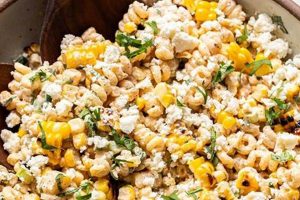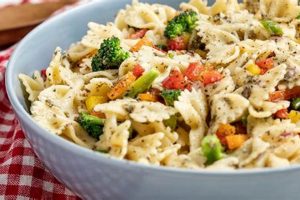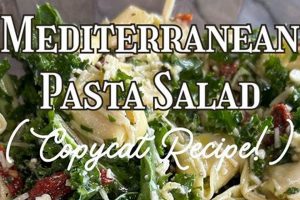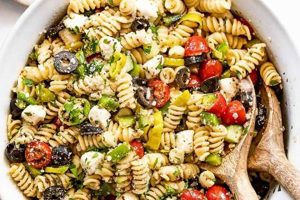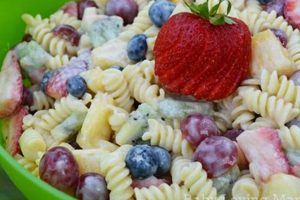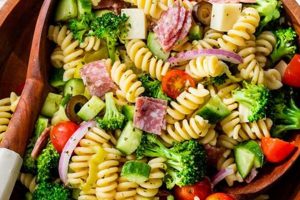Dishes combining cooked pasta, fresh spinach, and various other ingredients create a versatile and customizable salad option. These salads can incorporate a wide range of elements, including vegetables like tomatoes, bell peppers, and onions, proteins such as grilled chicken or chickpeas, cheeses like feta or parmesan, and a variety of dressings, from light vinaigrettes to creamy sauces. A simple example might include rotini pasta, baby spinach, halved cherry tomatoes, crumbled feta cheese, and a lemon-herb vinaigrette.
Such salads offer a balance of carbohydrates, vitamins, minerals, and protein, contributing to a nutritious meal. Spinach provides essential nutrients like vitamin K and folate, while the pasta offers a readily available source of energy. The inclusion of other vegetables and proteins further enhances the nutritional profile. These salads are adaptable to different dietary preferences, allowing for substitutions and additions based on individual needs and tastes. Historically, while pasta and spinach have been enjoyed for centuries in various cuisines, their combination in salad form is a more recent culinary development, reflecting a growing interest in healthy and convenient meal options.
This exploration will delve into the creation of these salads, covering topics such as ingredient selection, dressing preparation, variations for different dietary needs, and tips for achieving optimal flavor and texture.
Tips for Creating Exceptional Pasta Spinach Salads
Achieving a well-balanced and flavorful pasta spinach salad requires attention to several key factors. The following tips provide guidance for optimizing ingredient selection, preparation techniques, and flavor combinations.
Tip 1: Pasta Selection: Opt for short, sturdy pasta shapes like rotini, fusilli, or penne. These hold their shape well and readily capture the dressing and other ingredients.
Tip 2: Spinach Preparation: Thoroughly wash and dry the spinach before adding it to the salad. Excess moisture can dilute the dressing and make the salad soggy. Consider using baby spinach for a more delicate texture.
Tip 3: Blanching the Spinach (Optional): Briefly blanching the spinach can reduce its volume and enhance its vibrant green color. Ensure immediate cooling in ice water to prevent further cooking.
Tip 4: Ingredient Balance: Strive for a balance of flavors and textures. Combine the spinach and pasta with complementary vegetables, proteins, and cheeses.
Tip 5: Dressing Selection: Choose a dressing that complements the other ingredients. Light vinaigrettes, creamy dressings, or even a simple lemon-herb mixture can work well.
Tip 6: Timing is Key: Add the dressing shortly before serving to prevent the salad from becoming soggy. This also helps maintain the crispness of the vegetables.
Tip 7: Flavor Enhancement: Toasted nuts, seeds, or dried cranberries can add a layer of texture and flavor complexity.
By following these tips, one can consistently create pasta spinach salads that are both nutritious and delicious, offering a satisfying and versatile meal option.
These guidelines offer a strong foundation for crafting flavorful and visually appealing pasta spinach salads, paving the way for further culinary exploration and customization.
1. Pasta Variety
Pasta variety plays a crucial role in the overall success of a pasta spinach salad. Different pasta shapes offer varying textures and interact differently with dressings and other ingredients. The choice of pasta significantly influences the final dish’s flavor profile, visual appeal, and overall enjoyment. For instance, small, tubular pasta like ditalini or elbow macaroni absorbs dressings readily, creating a cohesive flavor experience. Conversely, larger shapes like farfalle or rotini offer textural contrast and capture ingredients within their folds, enhancing the sensory experience.
Choosing the correct pasta shape depends on the specific salad composition and desired outcome. A robust, ridged pasta like radiatore effectively clings to thicker dressings, while a delicate pasta like angel hair might be overwhelmed by heavier ingredients. In a salad with a light vinaigrette and cherry tomatoes, orzo or couscous offers a harmonious balance. Conversely, a heartier salad with grilled chicken and a creamy dressing benefits from the sturdiness of penne or fusilli. Careful selection ensures that the pasta complements rather than competes with other components.
Ultimately, the appropriate pasta shape enhances the overall composition and balance of the pasta spinach salad. Understanding the nuances of various pasta types allows for informed decisions, resulting in a dish where every element contributes to a cohesive and delightful culinary experience. Experimentation with different shapes provides opportunities to discover individual preferences and expand culinary creativity within the realm of pasta spinach salads.
2. Fresh Spinach
Fresh spinach serves as a cornerstone in pasta spinach salad recipes, contributing not only vital nutrients but also texture, color, and a subtly earthy flavor. Its versatility allows for seamless integration with various ingredients and dressings, making it an essential component. Understanding the nuances of selecting and preparing fresh spinach elevates these salads from simple to exceptional.
- Nutritional Value
Spinach boasts a rich nutritional profile, offering vitamins A, C, and K, as well as folate and iron. Incorporating fresh spinach into a pasta salad boosts its nutritional value significantly. This contributes to a more balanced and healthful meal, aligning with dietary guidelines that emphasize the consumption of leafy greens.
- Flavor and Texture
The slightly earthy and subtly sweet flavor of fresh spinach complements a wide range of ingredients, from tangy dressings to savory cheeses and proteins. Its tender yet resilient leaves provide textural contrast to the pasta and other components, creating a more dynamic and enjoyable eating experience. For example, baby spinach offers a delicate texture, while mature spinach provides a heartier counterpart.
- Preparation Methods
Proper preparation techniques maximize both the flavor and texture of fresh spinach. Thorough washing removes any grit or debris, while careful drying prevents the salad from becoming watery. Blanching spinach briefly intensifies its green color and reduces its volume, making it ideal for larger salads. Alternatively, incorporating raw spinach maintains its crispness and maximizes nutrient retention.
- Variety Selection
Different spinach varieties offer subtle variations in flavor and texture. Flat-leaf spinach is commonly used for its versatility, while Savoy spinach, with its crinkled leaves, provides a robust texture. Baby spinach offers a delicate sweetness and tender texture, making it a popular choice for salads. Selecting the appropriate variety further refines the overall salad experience.
The interplay of these facetsnutritional value, flavor, preparation, and varietydemonstrates the integral role fresh spinach plays in pasta spinach salad recipes. Its contributions extend beyond mere ingredient status, influencing the final dish’s overall healthfulness, sensory appeal, and culinary success. Consideration of these factors ensures a well-rounded and satisfying salad experience.
3. Complementary Ingredients
Complementary ingredients elevate pasta spinach salads from simple to sophisticated, contributing layers of flavor, texture, and visual appeal. These additions transform the base of pasta and spinach into a well-rounded, satisfying meal. Thoughtful selection and incorporation of complementary ingredients enhance nutritional value and create a more complex and enjoyable dining experience.
Several categories of complementary ingredients harmonize well with pasta and spinach. Proteins, such as grilled chicken, shrimp, or chickpeas, provide substance and satiety. Vegetables, including bell peppers, cherry tomatoes, red onion, or artichoke hearts, contribute color, texture, and distinct flavors. Cheeses, like feta, parmesan, or goat cheese, introduce salty, tangy, or creamy notes. Nuts and seeds, such as toasted almonds, sunflower seeds, or pumpkin seeds, offer crunch and healthy fats. Dried fruits, such as cranberries or raisins, provide bursts of sweetness and chewiness. These diverse elements, when combined thoughtfully, create a symphony of flavors and textures that enhance the overall sensory experience.
Consider a pasta spinach salad with grilled chicken, sun-dried tomatoes, and feta cheese. The chicken provides protein, the sun-dried tomatoes offer a burst of umami, and the feta contributes a salty tang. Alternatively, a salad with chickpeas, roasted red peppers, and toasted pine nuts presents a vegetarian option with a balance of protein, sweetness, and crunch. These examples illustrate how complementary ingredients interact synergistically to create a more complex and satisfying dish. Strategic choices result in a well-balanced salad that offers both nutritional value and culinary delight.
4. Flavorful Dressings
Flavorful dressings serve as the unifying element in pasta spinach salad recipes, transforming individual components into a cohesive and harmonious dish. The dressing’s role extends beyond simply adding moisture; it enhances flavors, balances textures, and contributes to the overall sensory experience. A well-chosen dressing elevates the salad from a collection of ingredients to a culinary creation.
- Balancing Acidity and Sweetness
The interplay of acidity and sweetness forms the foundation of many successful dressings. A vinaigrette, for example, balances the tartness of vinegar with the sweetness of honey or maple syrup. This balance prevents the dressing from being overly sharp or cloying, complementing the earthy spinach and the chosen pasta shape. The right balance enhances the flavors of other ingredients without overpowering them.
- Incorporating Flavorful Oils
The choice of oil significantly impacts the dressing’s flavor profile. Extra virgin olive oil provides a robust, peppery flavor, while avocado oil offers a smoother, more neutral taste. Infused oils, such as garlic or herb-infused olive oil, add depth and complexity. The oil acts as a carrier for other flavors and contributes to the dressing’s overall mouthfeel.
- Enhancing with Herbs and Spices
Fresh or dried herbs and spices contribute layers of flavor to the dressing. Basil, oregano, and thyme complement Mediterranean-inspired salads, while dill and chives pair well with lighter, brighter flavors. A pinch of red pepper flakes adds a touch of heat. These additions create nuanced flavor profiles that enhance the overall salad experience.
- Considering Texture and Emulsification
Dressings can range from thin and vinaigrette-like to thick and creamy. Emulsification, the process of combining oil and water-based ingredients, creates a stable and cohesive dressing. Creamy dressings, often incorporating mayonnaise or yogurt, provide a richer mouthfeel and cling well to pasta. The texture of the dressing should complement the other ingredients and contribute to the overall sensory experience.
The careful consideration of these facetsbalancing acidity and sweetness, incorporating flavorful oils, enhancing with herbs and spices, and considering texture and emulsificationdemonstrates the crucial role flavorful dressings play in pasta spinach salad recipes. A well-crafted dressing elevates the dish, unifying the flavors and textures of the individual components into a harmonious and satisfying culinary experience.
5. Proper Techniques
Proper techniques are essential for maximizing the flavor, texture, and overall quality of pasta spinach salad recipes. These techniques encompass various aspects of preparation, from cooking the pasta to assembling and serving the salad. Attention to these details ensures a dish that is not only visually appealing but also delivers a balanced and satisfying culinary experience. Neglecting these techniques can result in a subpar salad with mushy pasta, wilted spinach, or a poorly balanced flavor profile.
- Pasta Cooking
Cooking pasta al dente is crucial for achieving the desired texture in a pasta salad. Overcooked pasta becomes mushy and absorbs dressing less effectively, leading to a less enjoyable eating experience. Conversely, undercooked pasta is firm and unpleasant to chew. Properly cooked pasta provides a firm yet tender bite that holds its shape well in the salad. Salting the pasta water generously seasons the pasta from within and enhances its flavor.
- Spinach Handling
Proper handling of spinach ensures its optimal texture and flavor in the salad. Thoroughly washing and drying the spinach removes any grit and prevents excess moisture, which can dilute the dressing and make the salad soggy. If using mature spinach, consider removing the thick stems for a more tender texture. For baby spinach, simply ensure it is clean and dry.
- Ingredient Incorporation
The timing and order of ingredient incorporation significantly influence the final salad’s quality. Adding the dressing too early can lead to soggy ingredients, particularly the spinach. It’s best to add the dressing shortly before serving to maintain the crispness of the vegetables and prevent the pasta from absorbing too much dressing. Distributing ingredients evenly ensures that each bite contains a balanced combination of flavors and textures.
- Temperature Control
Serving the salad at the correct temperature enhances its overall appeal. While some pasta salads are served cold, others are best enjoyed at room temperature or slightly chilled. Allowing the pasta to cool slightly before adding other ingredients prevents the spinach from wilting. Serving the salad at the appropriate temperature maximizes its flavor and textural qualities.
These techniques, when executed correctly, contribute significantly to the overall success of pasta spinach salad recipes. From perfectly cooked pasta to properly handled spinach and strategically timed ingredient incorporation, each step plays a crucial role in creating a balanced and enjoyable culinary experience. Mastering these techniques elevates the simple pasta spinach salad to a dish that is both delicious and visually appealing.
Frequently Asked Questions
This section addresses common inquiries regarding the preparation and enjoyment of pasta spinach salads, offering practical guidance and clarifying potential uncertainties.
Question 1: What type of pasta works best in these salads?
Short, sturdy pasta shapes like rotini, fusilli, penne, or farfalle hold their shape well and capture the dressing effectively. Smaller shapes like orzo or ditalini also work well, particularly with lighter dressings.
Question 2: Can frozen spinach be used?
While fresh spinach is generally preferred for its texture and flavor, frozen spinach can be used in a pinch. Ensure it is thoroughly thawed and squeezed dry to remove excess moisture before incorporating it into the salad.
Question 3: How long can pasta spinach salad be stored?
Properly stored in an airtight container in the refrigerator, pasta spinach salad can typically last for 3-5 days. However, the addition of certain ingredients, such as proteins, may shorten its shelf life.
Question 4: What are some suitable protein additions?
Grilled chicken, shrimp, salmon, chickpeas, cannellini beans, and hard-boiled eggs are all excellent protein additions, enhancing both the nutritional value and satiety of the salad.
Question 5: How can one prevent the salad from becoming soggy?
Adding the dressing shortly before serving is key to preventing sogginess. Ensuring that the spinach is thoroughly dried and using appropriately cooked pasta also helps maintain the salad’s desired texture.
Question 6: Can these salads be adapted for different dietary needs?
Absolutely. Gluten-free pasta can be substituted for traditional pasta, and the choice of protein and other ingredients can be tailored to accommodate vegetarian, vegan, or other dietary restrictions.
Addressing these frequently asked questions provides a foundation for successful pasta spinach salad preparation. Understanding these key considerations empowers individuals to create delicious and satisfying salads tailored to individual preferences and dietary needs.
The following section will explore variations on the classic pasta spinach salad recipe, demonstrating the versatility and adaptability of this dish.
Pasta Spinach Salad Recipes
Exploration of pasta spinach salad recipes reveals a versatile culinary canvas. Careful selection of pasta shapes, utilization of fresh spinach, incorporation of complementary ingredients, and creation of flavorful dressings contribute to a balanced and satisfying dish. Proper techniques, from pasta cooking to ingredient handling, ensure optimal texture and flavor. Adaptability to dietary needs and preferences further broadens appeal. From simple combinations to elaborate creations, the foundational elements remain consistent: quality ingredients and thoughtful preparation.
Pasta spinach salad recipes offer a gateway to culinary creativity and nutritional exploration. Continued experimentation with diverse ingredients, flavor profiles, and presentations promises an evolving landscape of culinary possibilities within this seemingly simple dish. The potential for customization and adaptation ensures its enduring relevance in a dynamic culinary world.

